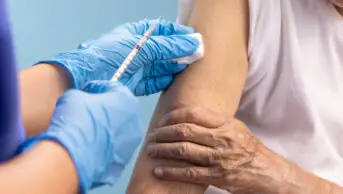
Mclean/Shutterstock.com
Controlling risk factors — such as blood lipid levels — is central to the secondary prevention of cardiovascular events in patients with a history of such events. In practice, this is often far from straightforward.
On 1 September 2021, the National Institute for Health and Care Excellence (NICE) issued draft final guidance recommending inclisiran (Leqvio; Novartis) for people with primary hypercholesterolaemia or mixed dyslipidaemia, who have already had a cardiovascular event[1,2]. Specifically, inclisiran is now a recommended option in a group of secondary prevention patients that is often difficult to manage: those with persistently high low‑density lipoprotein cholesterol (LDL-C) levels despite maximum tolerated therapy with other lipid-lowering agents, such as statins and ezetimibe, but with LDL-C below the NICE thresholds for eligibility for proprotein convertase subtilisin/kexin type 9 (PCSK9) monoclonal antibodies (PCSK9i) evolocumab and alirocumab (NICE technologies appraisal guidance TA393/4).
NICE’s guidance on inclisiran was warmly welcomed. It is certainly an exciting new therapy that offers important clinical firsts, both in terms of its novel mode of action (based on RNA interference-mediated reduction of PCSK9 production) and low frequency of administration (twice-yearly injection) — the latter may be particularly important in routine practice because it could help to improve adherence. The lipids management pathway will be updated to reflect this development[3].
Meindert Boysen, deputy chief executive of NICE, hailed inclisiran as “a potential game-changer” in preventing premature deaths from heart attack and stroke. This is correct — as long as the word “potential” remains attached.
But, for patients currently living with cardiovascular disease, does this announcement really change the game? There are several factors that should moderate expectations around inclisiran, at least in the short term.
Data are promising but incomplete
First and foremost, the overall data set is currently limited. Although inclisiran demonstrated excellent lipid-lowering efficacy in phase 3 trials, we are still awaiting cardiovascular outcomes data[4]. Ultimately, it is the prevention of heart attack and stroke that matters; surrogate endpoints, such as the reduction in LDL-C, are helpful but do not tell the full story.
Furthermore, direct comparisons of inclisiran with other relevant treatment options — including ezetimibe and the PCSK9 monoclonal antibodies (PCSK9i) alirocumab and evolocumab — are lacking. Such comparisons will be important in delineating optimal treatment combinations and sequences.
In addition, while inclisiran appeared to be safe over 18 months of use in clinical trials, long-term safety results are not yet available[4].
Further data are also needed in the high risk primary prevention setting, including familial hypercholesterolaemia. For the moment, NICE guidance limits inclisiran use to individuals with a history of previous cardiovascular events.
Practicalities of inclisiran use could be problematic
The press release from NICE has suggested that up to 300,000 eligible patients in England could receive inclisiran over the next three years[1]. This sounds like an ambitious estimate. Indeed, the rollout of the PCSK9 inhibitors showed that initial usage was only around 15% of the expected levels, possibly owing to the barriers listed below[5]. In the same way as inclisiran, these treatments are administered by injection, and it may be that practitioners and patients are still adjusting to the use of injectables in an area of medicine previously dominated by oral treatments.
NICE has also said that inclisiran can be given in primary care settings; while this is a welcome proposal, it will undoubtedly require substantial restructuring of local lipid management pathways. Up until now, patients requiring treatments beyond statins and ezetimibe have typically been referred to secondary care. Furthermore, significant investment will be needed to meet the challenges of training practitioners and educating patients on this novel injectable medicine. It is questionable how readily all this can be achieved in the current healthcare environment, with so much attention focused elsewhere — for example, on managing the COVID-19 pandemic and reducing patient waiting lists.
Upstream treatment pathway requires urgent improvement
While inclisiran is a promising treatment, it is not a magic bullet that can fix all problems. The NICE guidance rightly emphasises the need to first optimise lipid management with current evidence-based medicines — and to only introduce inclisiran if adequate reductions in non-H[high]DL-/LDL-C cannot be achieved with the maximum tolerated lipid‑lowering therapy[2].
Much work needs to be done to improve upstream management pathways of possible inclisiran use, and pharmacy teams can play a central role. The NHS Accelerated Access Collaborative Rapid Uptake Product programme for lipid management, which looks atPCSK9i, high-intensity statins and ezetimibe uptake nationally, has identified various barriers[6]. These must be addressed if we are to optimise current practice and enable appropriate therapeutic escalation to inclisiran when required.
Key barriers include the following:
- The process of identifying patients with dyslipidaemia who might benefit from optimisation of lipid-lowering therapies is currently unsatisfactory. This is possibly owing to the lack of incentives and initiatives to drive cholesterol measurement or management.
- There is substantial evidence of underuse of established lipid-lowering therapies, including statins, ezetimibe and PCSK9 inhibitors[7–9].
- For example, a recent UK analysis of statin utilisation in general practice found that 45% of prescriptions were below the recommended strength, with broad inter-practice variations[7].
- Such underuse continues to be a widespread problem, despite the fact that these medicines have proven benefits on cardiovascular outcomes[10]. Several factors could be driving this including: cost; lack of capacity and lipid management pathways; the need for fasting LDL-C samples, which can be inconvenient for patients and limits when the sample can be taken; and limited awareness.
- Routine monitoring of lipid levels in these patients is typically not undertaken as often as it should be – and hence optimisation of therapy is often poor. This is possibly owing to the old ‘fire and forget’ approach in managing lipids — where a standard dose of statins is prescribed to a high-risk patient without further testing or dose adjustment — which continues to be used in some areas.
- Patients are commonly labelled as ‘statin intolerant’ and switched to alternative therapies without exploring whether their intolerance is genuine.
- For example, in an analysis of more than 6,000 patients whose statin treatment was discontinued because of clinical events or symptoms believed to have been caused by statin use, and who were subsequently rechallenged, 92% were still taking a statin 12 months after the original event[11].
- It is becoming increasingly clear that statin rechallenge is often successful after a brief ‘drug holiday’, as side effects perceived to be caused by statins do not seem to change when statins are reintroduced. The dechallenge-rechallenge approach should therefore be considered — possibly using an alternative regimen, dose or type of statin — before switching to alternative agents[12].
- We have developed a statin intolerance pathway to support clinicians in managing this phenomenon[13]. The HEART UK website has some role play consultations that highlight this issue.
- Bridging the LDL-C threshold gap between the PCSK9i LDL-C threshold of >3.5 and >4 mmol/L (depending on level of cardiovascular disease risk) and that of inclisiran (≥2.6mmol/L). This is in view of several cardiovascular outcome trials being published after publication of the NICE technologies appraisals on alirocumab and evolocumab in 2016. Evidence showed a reduction in cardiovascular events across various vascular territories (coronary, cerebral and peripheral vascular disease)[14,15].
Pharmacy teams are encouraged to review the NICE-endorsed lipids and statin intolerance pathways that can be found here.
Conclusion
Inclisiran offers significant potential in the secondary prevention of heart attack and stroke in patients with persistently elevated blood cholesterol. However, before it can truly be considered a ‘game changer’, several hurdles must be surmounted — particularly in expanding the underlying trial data set and building delivery capability in primary care.
Furthermore, excitement around this novel medicine must not distract from the task of optimising established lipid management pathways. Only then will it be possible to appropriately intensify current therapies and identify candidates for inclisiran treatment. Pharmacy teams can play a central role in this process, thereby enabling better lipids optimisation and improving outcomes for our patients.
Rani Khatib is a consultant pharmacist in cardiology & cardiovascular research, lead of the Innovative Medicines Optimiation Clinic at Leeds Teaching Hospital NHS Trust; national clinical champion for PCSK9i and Lipids Management at NHS England Accelerated Access Collaborative; and honorary senior lecturer at the Leeds Institute of Cardiovascular and Metabolic Medicine.
Dermot Neely is head of the department of clinical biochemistry at Newcastle upon Tyne Hospitals NHS Trust, and lead consultant at the Lipid and Metabolic Clinic at Royal Victoria Infirmary in Newcastle.
Both are authors of NHS England’s Accelerated Access Collaborative lipid management pathway and the accompanying statin intolerance pathway.
- 1NICE approves ground-breaking cholesterol-lowering drug inclisiran. National Institute for Health and Care Excellence. 2021.www.nice.org.uk/news/article/nice-approves-ground-breaking-cholesterol-lowering-drug-inclisiran (accessed Nov 2021).
- 2Inclisiran for treating primary hypercholesterolaemia or mixed dyslipidaemia. National Institute for Health and Care Excellence. 2021.www.nice.org.uk/guidance/gid-ta10703/documents/html-content-2 (accessed Nov 2021).
- 3Summary of national guidance for lipid management for primary and secondary prevention of CVD. NHS Accelerated Access Collaborative. 2021.www.england.nhs.uk/aac/wp-content/uploads/sites/50/2020/04/Lipid-Management-Pathway-NEW.pdf (accessed Nov 2021).
- 4Ray KK, Wright RS, Kallend D, et al. Two Phase 3 Trials of Inclisiran in Patients with Elevated LDL Cholesterol. N Engl J Med 2020;382:1507–19. doi:10.1056/nejmoa1912387
- 5NICE Technology Appraisals in the NHS in England (Innovation Scorecard) to December 2020. National Institute for Health and Care Excellence. 2021.https://digital.nhs.uk/data-and-information/publications/statistical/nice-technology-appraisals-in-the-nhs-in-england-innovation-scorecard/to-december-2020/2.-estimates-report (accessed Nov 2021).
- 6Lipid management — rapid uptake product. NHS Accelerated Access Collaborative. 2021.www.england.nhs.uk/aac/what-we-do/what-innovations-do-we-support/rapid-uptake-products/lipid-management (accessed Nov 2021).
- 7Curtis HJ, Walker AJ, MacKenna B, et al. Prescription of suboptimal statin treatment regimens: a retrospective cohort study of trends and variation in English primary care. Br J Gen Pract 2020;70:e525–33. doi:10.3399/bjgp20x710873
- 8García-Ulloa AC, Lechuga-Fonseca C, Del Razo-Olvera FM, et al. Clinician prescription of lipid-lowering drugs and achievement of treatment goals in patients with newly diagnosed type 2 diabetes mellitus. BMJ Open Diab Res Care 2021;9:e001891. doi:10.1136/bmjdrc-2020-001891
- 9Just one-third of European patients get to LDL cholesterol goals. tctMD. 2020.www.tctmd.com/news/just-one-third-european-patients-get-ldl-cholesterol-goals (accessed Nov 2021).
- 10Packard C, Chapman MJ, Sibartie M, et al. Intensive low-density lipoprotein cholesterol lowering in cardiovascular disease prevention: opportunities and challenges. Heart 2021;107:1369–75. doi:10.1136/heartjnl-2020-318760
- 11Zhang H, Plutzky J, Skentzos S, et al. Discontinuation of Statins in Routine Care Settings. Ann Intern Med 2013;158:526. doi:10.7326/0003-4819-158-7-201304020-00004
- 12Fitchett DH, Hegele RA, Verma S. Statin Intolerance. Circulation 2015;131. doi:10.1161/circulationaha.114.013189
- 13Statin intolerance pathway. NHS Accelerated Access Collaborative. 2021.www.england.nhs.uk/aac/wp-content/uploads/sites/50/2020/08/Statin-Intolerance-Pathway-NEW.pdf (accessed Nov 2021).
- 14Oyama K, Giugliano RP, Tang M, et al. Effect of evolocumab on acute arterial events across all vascular territories : results from the FOURIER trial. European Heart Journal Published Online First: 19 September 2021. doi:10.1093/eurheartj/ehab604
- 15Ray KK, Colhoun HM, Szarek M, et al. Effects of alirocumab on cardiovascular and metabolic outcomes after acute coronary syndrome in patients with or without diabetes: a prespecified analysis of the ODYSSEY OUTCOMES randomised controlled trial. The Lancet Diabetes & Endocrinology 2019;7:618–28. doi:10.1016/s2213-8587(19)30158-5


